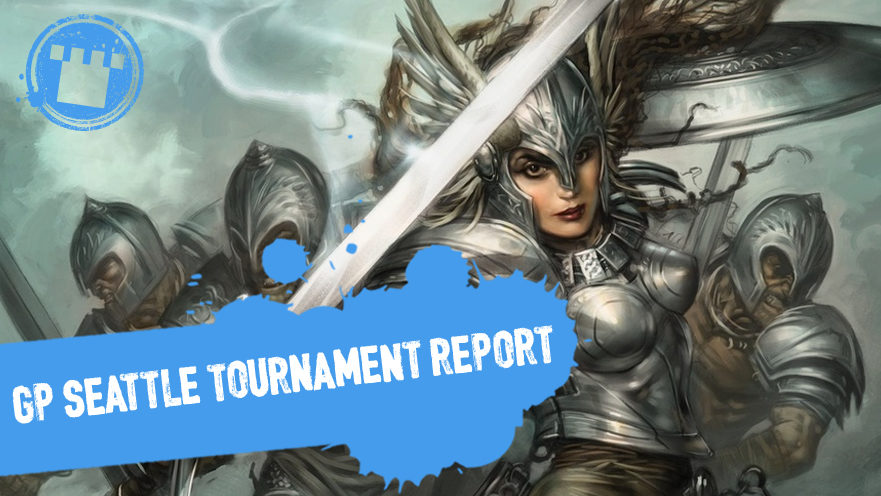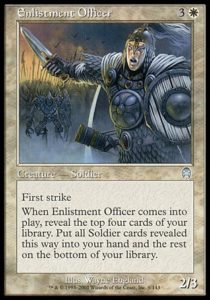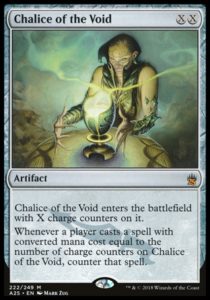As I prepared for Grand Prix Seattle, I knew I wasn’t very familiar with Legacy – not nearly as familiar as I was with the other Grand Prix format. What the heck, I thought, let’s play something fun and focus your testing on Standard. Having played Legacy Soldiers at Mox Boarding House’s Duel for Duals the previous Wednesday to a rather mediocre 3-4 record, I was anticipating a similar performance at the Grand Prix. A top 64 finish and three feature matches later, I’m starting to think that maybe I should’ve focused my testing on Legacy instead.
Chantelle’s Soldier Stompy | 56th, Grand Prix Seattle – Legacy
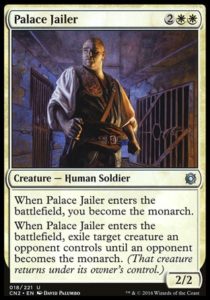
3 Aerial Responder
2 Captain of the Watch
2 Daru Warchief
4 Enlistment Officer
3 Palace Jailer
4 Preeminent Captain
3 Recruiter of the Guard
4 Thalia, Guardian of Thraben
4 Thalia, Heretic Cathar
4 Chalice of the Void
4 Chrome Mox
4 Suppression Field
8 Plains
4 Ancient Tomb
4 Cavern of Souls
1 City of Traitors
2 Karakas
Sideboard
2 Armageddon
3 Cast Out
1 Containment Priest
1 Eidolon of Rhetoric
2 Holy Light
2 Rest in Peace
2 Selfless Squire
2 Sorcerous Spyglass
The Deck
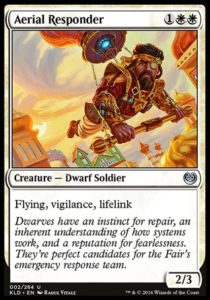
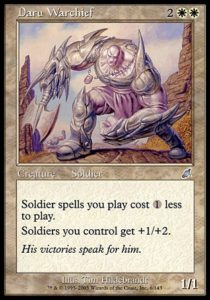
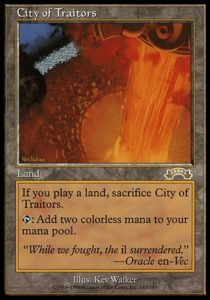
While I highlighted Soldier Stompy as my deck of choice in a previous article, I wanted to walk through a few of the choices I made for the GP. I originally ran Ballyrush Banneret, but switched to Aerial Responder as a concession to the ever-popular Delver decks in the format. As a result, I needed to shave a few copies of City of Traitors so I could generate two white mana and cast Responder more consistently. I also cut down on the number of Daru Warchiefs I was running to increase the number of Palace Jailers in the main. Overall, my changes slightly decreased the explosiveness of the deck, but I think the increase in consistency is worth it.
The Sideboard
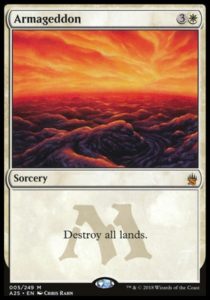
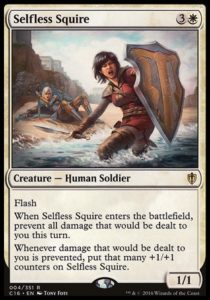
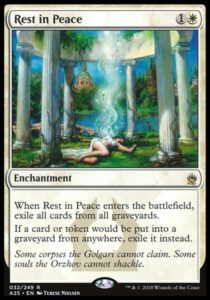
During testing, the one-of Armageddon in my sideboard over-performed against greedy mana decks such as Lands and Miracles. My original plan was to run a Ravages of War over a second Armageddon, but failing to find one in time, two Armageddons did the trick. Cast Out provided a great answer to cards like Ensnaring Bridge (which had recently been seeing an increase in play), as well as big bomby threats such as Emrakul, the Aeons Torn.
In addition to the Aerial Responders in the main deck, I went up to two Holy Lights in the sideboard in the face of a field full of Grixis Delver (even though I ended up playing against Delver only once). Selfless Squire was a particularly under-the-radar choice that felt strong against both the decks attempting to go tall by cheating out fatties and the decks with go-wide creature strategies – everything from Sneak and Show to Merfolk.
I chose two Rest in Peace over Faerie Macabre due to the poor interaction between the latter and Suppression Field, though I can see a graveyard interaction effect that you can tutor for with Recruiter of the Guard being valuable. Sorcerous Spyglass, Eidolon of Rhetoric, and Containment Priest round out the sideboard as catch-alls against a variety of match-ups, and I felt they gave me the ability to cover the largest swath of the metagame.
As it turns out, over the course of Friday and Saturday, I would need all those sideboard cards, as I faced thirteen different decks in my thirteen rounds.
Day One
As I came off my two byes and entered Round 3, I found myself paired against an opponent who wasn’t familiar with many of my cards. As it turns out, this would be a recurring theme throughout the weekend. A Toxic Deluge for two with an Enlistment Officer in play (a 2/3) is an anecdote that most accurately summarizes the next three rounds, and how I find myself at 5-0, and sitting across from Athena Froehlich.
“Two women in the community,” Athena commented. “We’re probably going to get a feature match.” Not a minute after I responded with a laugh and a “nah,” our names were called to report to the feature match area – a world away from the GP tables, and my first time in front of the Grand Prix cameras and commentators. I was lucky to have interacted with Athena prior to our match, and she made what should have been an incredibly stressful experience much more manageable. We both knew each other’s decks, and I imagined her plan was to ramp out big threats that could outpace my little army. Before I could attack for lethal in Game 1, Athena ran out an Ugin that made quick work of my board of small white creatures; and while the second game was still incredibly interesting, with two Ulamogs jailed under my Monarch token, Athena used two Thought-Knot Seers to pick apart my hand and set up for a lethal attack.
In Round 7, after an exciting three games against an opponent on Little Red, I found myself at 6-1, and locked for Day 2 – a far cry from the 3-5 drop I was anticipating! One more round to hopefully finish my day at 7-1! I thought. Unfortunately, my Aggro Loam opponent had other plans. I ended up with a 6-2 record, unsure if my Soldiers would be able to slug it through another seven rounds of Legacy or if my time would be better spent playing in the Standard Grand Prix – the one I had actually spent time preparing for.
Ultimately, I decided that a Day 2 is not a gift horse that I was willing to look in the mouth, and the ability to play Sunday PTQs if I fell short of my Legacy expectations swung the vote toward playing it out.
Day Two
On Saturday, I rolled in rather groggily – coffee in hand, ready to settle into a quiet first match of the day – when my name was once again called to report to the feature match area! This time, I wasn’t sitting in the back-up seats. My match was front and center, where the commentators and audience could judge my plays in real time. Being in the hot seat for the first time was an incredibly stressful way to start my morning, and going back and watching my match and seeing all of my misplays, missed tax effects and missed Monarch draws, I can’t help but cringe. However, the ability to review and analyze my play and consider lines that I might have missed is extremely beneficial.
Afterward, I was able to pick up another three wins, including a third feature match, to find myself at 10-2 with only three rounds between me and my first ever Grand Prix Top 8. However, in Round 13, I lost to a Lands player who mentioned playing Soldiers for fun and proceeded to play perfectly around my potential prison pieces and answers, reaffirming that a fair portion of this deck’s strength lies in people’s unfamiliarity with it. A second loss came shortly thereafter, to Matt Nass on a Tin Fins and Dark Depths combo deck that could easily win on Turn One, before I had the opportunity to deploy any of my prison pieces.
My final match was against an Elves player, and I took a quick Game One off the back of Chalice of the Void. In Game Two, my opponent was quite methodical in his decision-making, and while I had the Selfless Squire to blank his lethal attack, he had left back enough blockers to prevent me from closing out the game. After agreeing that a draw would leave us both dead for Top 64, we discussed that I would be on the play if we were able to go to Game Three, and with that in mind, he conceded to me – an incredibly thoughtful act.
Conclusion
I don’t think there are many changes I would make to this list as I look to play it in the future. The second Holy Light might be unnecessary, and I may switch it back to a fourth Palace Jailer. I also might try to find room for a third Karakas in the main deck, as legendary creatures dominate so much of the format.
While I didn’t get the ending I’d hoped for, I’m so proud of the performance my little army was able to put up at Grand Prix Seattle. Not only did I get my first (and second, and third!) feature match, I also got to highlight this deck as an option for many would-be Soldier Stompers, and the outpouring of support I’ve received has been unbelievable. I might be known as “Soldiers Girl” at events going forward, but that’s a moniker I’ll wear with pride.
Header design: Justin Treadway
Header image: “Captain of the Watch” by Greg Staples
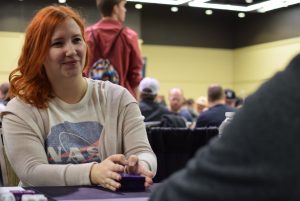
A Spike at heart, Chantelle spends her free time prepping for tournaments, working toward the ever-elusive Mythic Championship, and championing other competitive ladies. She’s a combo aficionado and seasoned aggro deck player, and Standard and Modern are her preferred formats. Growing and improving as a player, both technically and in her mental game, are of the utmost importance to her.

